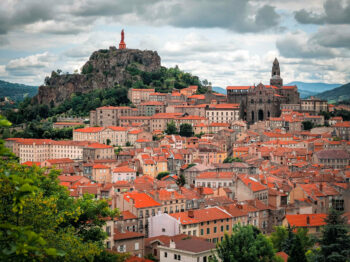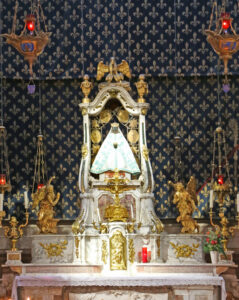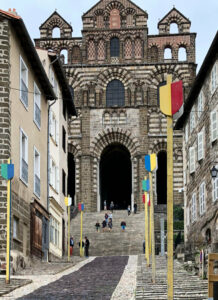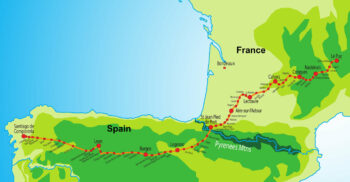Le Puy-en-Velay – the beginning of the Journey

By Fr Mark Walls SM
Le Puy-en-Velay is of great significance in the Marist story. It was there that the initial inspiration for the founding of the Society of Mary took place. It was, in that sense, the beginning of the Marist journey. It is also the starting point of the most famous of all the Camino pilgrimage routes that lead to Santiago de Compostela in Spain. It held special significance for me as I started out on that journey.
Le Puy-en-Velay is situated in the Massif Central, three kilometres from the left bank of the Loire River in south-central France. It is famous for its green lentils and its traditional lace-making studios, but its most striking attraction is the Cathédrale Notre-Dame du Puy, dating from the first half of the twelfth century. Devotion to Mary, the Mother of Jesus, in Le Puy can be traced back to the early middle ages when pilgrims, including Charlemagne, visited a shrine which is said to have been where the main altar of the Cathedral is now situated.

Le Puy-en-Velay
Photo: Lytheo / Theo BERTRAND
I have visited the Cathedral at Le Puy-en-Velay three times. The first two visits, with education colleagues and then young co-workers, on pilgrimage to Our Lady of Le Puy. Her shrine is to the right of the main altar in the Cathedral, and her image is in black ebony, dressed in brocade that is coloured according to the liturgical season. This so-called “black Madonna,” a popular depiction in France, was presented first to the Cathedral by King Louis IX in 1254. The image was destroyed during the Revolution, but replaced at the Restoration with a copy that continues to be venerated. We celebrated Mass in the ancient Chapel of St Martin that had been closed for four hundred years, and later at the altar of Our Lady of Le Puy. We prayed for everyone, all those Marists down through the ages whose journey had begun right there, and was still in progress. Le Puy was the beginning, but it was a vision, and visions only end when we die.
Early in the morning of 15 August 1809, a young Jean-Claude Courveille came to the Cathédrale Notre-Dame du Puy. He sought out the shrine of Our Lady and prayed for a cure for his blindness, a result of a childhood skirmish with smallpox. He took some oil from the large votive lamp receptacle and wiped it over his eyes. According to his account, his sight was

The Black Madonna of Le Puy-en-Velay
Photo: W. Bulach
immediately restored. He attributed the miracle to the intercession of Our Lady of Le Puy. In thanksgiving, he would return to the shrine at the Cathedral each year on 15 August. Three years later, in 1812, as he sat before the image of the Virgin Mary “he heard, not with his bodily ears, but with those of the heart, interiorly but very distinctly: ‘Here…..is what I want…….another Society…..one consecrated to me, one which will have my name, which will call itself the Society of Mary, whose members will call themselves Marists.’”
Later as a seminarian, Courveille shared that vision with others. Like him, they saw the Marist project as something which seized them and called them. Among them was Jean-Claude Colin. Courveille showed in later interactions that he did not have the character to continue with the Marist project, but Colin did, and he took Courveille’s extraordinary experience at Le Puy-en-Velay and carried on the journey to the foundation of the Society, seeing it through to final approbation in 1836, and beyond.
The Marist journey took many twists and turns as it grew and reached the furthest ends of the earth, and now, from the furthest ends of the earth, Marist pilgrims come back to Le Puy-en-Velay. They sit where Courveille sat, and kneel where he knelt. The dish with the votive lamp still hangs in the same place, and it’s easy to wonder what ills the oil might now heal.
My third visit to the Cathedral at Le Puy-en-Velay was to attend the early-morning Mass with fellow pilgrims about to be sent forth on the Chemin du Puy, or Via Podiensis, a journey on foot of nearly eight hundred kilometres that would bring me, thirty-eight days later, to Saint-Jean-Pied de Port, a tiny town nestled in the French side of the Pyrenees, and the starting point of the Camino Frances. Ten years earlier I had left Saint-Jean-Pied de Port as I headed to Santiago de Compostella, and so, somewhat back-to-front, I was now setting out to complete the journey.

Pilgrims leaving Cathédrale Notre-Dame du Puy to begin their pilgrimage
I left Le Puy as I had left Saint Jean and arrived at St Jean as I had arrived at Santiago, but the journey wasn’t finished. The Chemin du Puy is more punishing than the Camino Frances, less-travelled, with rougher terrain, sharper climbs and more precipitous descents, but the countryside and the mountains are as spectacular as they are varied. Both journeys are physically challenging, but a pilgrimage teases the mind and soul as well, so the destination is really in the journey itself.
South-west France wears its ancient faith on its sleeve rather than in the hearts of its people. Statues of the Virgin Mary abound, from the tiny, in little niches on the corners of shops overlooking the village streets, to the life-sized, in the town squares commemorating the parish mission of some yesteryear in the late 19th or early 20th century, to the colossal, like the one overseeing the Valley of Lot, seeming to dare the unfaithful to venture there. The churches, though, are almost empty of other than pilgrims passing by, making me think about the twists and turns of the journey, of having to keep going to see what lies around the next corner, of embracing the vision and believing in it, of remembering Le Puy, the literal and the metaphorical.
In Zabaldika, a tiny village of eight houses along the way, the Pilgrim’s Beatitudes is printed on the back wall of the 9th century church. One of the Beatitudes says: “Blessed are you, pilgrim, because you have discovered that the authentic ‘camino’ begins when it is completed.” Le Puy-en-Velay the birth-place of the Marist vision, the beginning of a journey, and a destination.

Map of the Chemin du Puy from Le Puy to St Jean Pied de Port joining to the Camino Frances and ending in Santiago de Compostela
 Entries(RSS)
Entries(RSS)